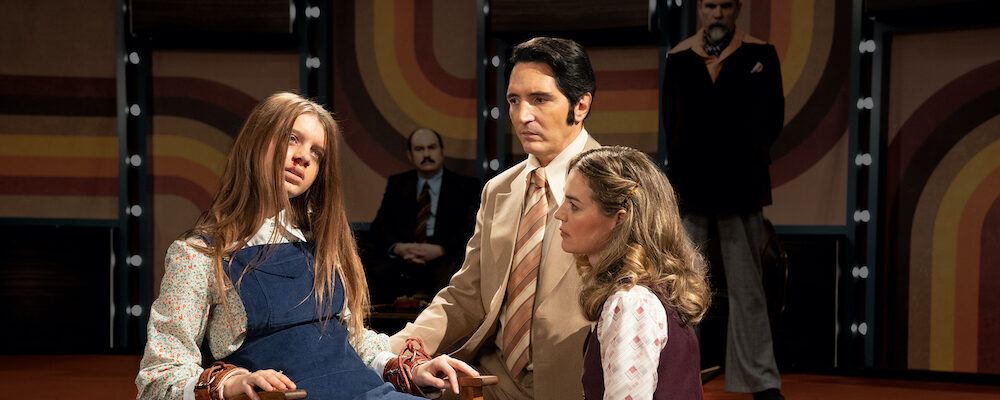‘Late Night With the Devil’ Is a Funny and Frightening Found Footage Horror That Flips the Dial
Tony Sokol
Don’t touch that dial. “Late Night With the Devil,” from sibling writing and directing team Cameron and Colin Cairnes, is a must watch for horror fans, and a true innovation for found footage motion pictures. The film is set on Halloween night in the war weary and violent crime-ridden late 1970s, in the midst of the most barebones battles to bloody the times: A late night talk show during sweeps weeks. This period production slightly skewers the television landscape while maintaining a realistic ambiance. Any film which establishes the era’s time signature with Flo and Eddie’s “Keep It Warm” is what a witch doctor would order. It feels somehow forbidden, like inappropriate laughter. Even the omnipresent owl on the station breaks, and technical difficulties cards mock the viewer with visions of devilish doings among tall trees.
Jack Delroy (David Dastmalchian), who hosts the promising network show “Night Owls,” would sell his soul to beat Johnny Carson’s “Tonight Show” in the ratings. As far as he is concerned, that’s just an expression, but his producer Leo (Josh Quong Tart) books a guest panel with other ideas. The bulk of “Late Night With the Devil” is presented as uncut footage from the broadcast feed, not seen since it aired live.
The fictitious 1970s episode is irreverently loving to its satirical symbols. Referencing real-life late-night regulars, like horror royalty Vincent Price, “Late Night With the Devil” highlights how the assembled panel resembles the esoteric figures of the time. Kreskin bent spoons. The Amazing Randi routinely offered money to anyone who could prove the improbable. Jay Anson’s 1977 New York Times Bestseller “The Amityville Horror” put Ed and Lorraine Warren on TV screens nationwide.
Christou (Fayssal Bazzi), the lost episode’s guest psychic, is even more intense than the recurring “Stupendous Yappi” character from “The X-Files,” while his batting average on spirit communication hits a slippery slump. Carmichael the Conjurer (Ian Bliss), is a magician and paranormal debunker whose feats of mass hypnosis wreak havoc on proceedings, attempting to break the fourth wall, a no-no on 70s television.
The fourth and fifth walls are shattered, however, by the main attraction: a possessed 13-year-old girl called Lilly (Ingrid Torelli) who can conjure lesser demons as easily as she can command a stage through enthusiastic eye contact. Her paranormal investigator handler, Dr. June Ross-Mitchell (Laura Gordon), is also a magnetic presence, the only character pulling against the grain of blackened mass accommodation. Gordon has one major moment in a versatile performance. June loses a decision to an audience request, and fights back against the fear, and public humiliation she experienced and sees coming.
The mockumentary feel comes from the introductory segment authoritatively narrated by Michael Ironside. The eight-minute montage shows stock footage of Presidents Nixon and Carter, the Twin Towers, the gas crisis, Charles Manson, and the rise of satanism against the backstory of Jack Delory. Discovered as a Chicago radio DJ, he marries a stage actress named Madeleine (Georgina Haig), who ultimately succumbs to cancer. Dastmalchian underplays Jack’s growing desperation, internalizing the expiring contracts and free-falling ratings while maintaining a showman’s charisma. The madness is palpable, the regrets very real.
The only other deviation from the real-time run of the fictitious episode is the show’s a pre-taped explanatory short about Lily, the sole survivor of a mass suicide of a renowned Satanic cult. Serving the demon Abraxas, they were accused of breeding children for sacrifice. Lily always wants to know which camera to focus on, as each glance offers a glimpse of an invitation to another world.
Location. Location. Location. In the grand tradition of glorious independent films of the era, the cost-effective single setting of a TV studio rivals past masters, like Roger Corman, who made efficient use of leftover sets of larger films when shooting on rented lots. The cameras, microphones, dials, and backstage area feed the authenticity of the premise, conveniently capture the best footage, and offer the freedom to get it from multiple angles. Production designer Otello Stole made his bones on Australian television, and recreates the look while giving ample ammunition to subvert the aesthetic. Though he should have known the cameras would remain static during the commercial breaks, and not follow the off-air action as it moved off the sound stage. Ironically, this gaff only adds to the overall realism, and the tapestry of suspense.
Costume designer Stephanie Hook seamlessly weaves a perfect picture of the look of the time, even the tacky cheap devil costume trusty sidekick Gus (Rhys Auteri) worms his way out of feels like it was bought on sale when the episode aired. While Carmichael always has something up his sleeve, “Late Night With the Devil” shoots the cuffs to highlight its influences. Lily’s Mr. Wiggles recalls Captain Howdy, Regan’s (Linda Blair) friend in “The Exorcist.” The fictitious UBC network which broadcasts “Night Owls” may be a nod to the UBS Evening News of Paddy Chayefsky and Sidney Lumet’s 1976 media satire “Network.”
“Late Night With the Devil” successfully messes with expectations, and keeps heads reeling, especially, as a late film break in style, film stock, and tone. The unease more than makes up for the minimal gore, which allows the effects to impose themselves subtly through glitchy video images and flickering lights before gaining enough electricity to overload a Theremin and call a demon.
“Late Night with the Devil” releases March 22 in select theaters and begins streaming April 19 on Shudder.

